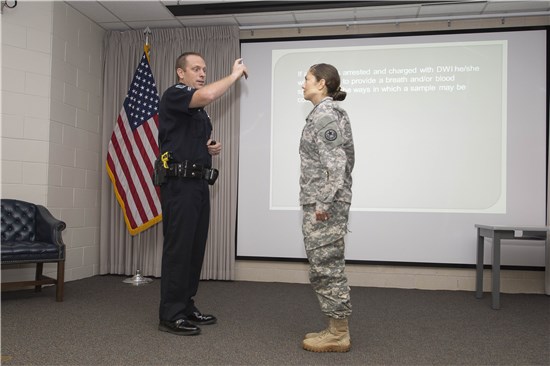 |
| Detective Mike Jennings, Driving While Intoxicated Program Coordinator, Austin Police Department gives Capt. Martha Nigrelle, Joint Force Headquarters, Texas Military Forces, a field sobriety test during a presentation at Camp Mabry in Austin, TX, August 2, 2014. Jennings briefed soldiers from the Joint Force Headquarters on what his department is doing to prevent DWI-related casualties in the city and how to help prevent DWI accidents. (U.S. Army National Guard photo by Sgt. 1st Class Malcolm McClendon). |
Commentary by: Capt. Martha Nigrelle
Detective Mike Jennings, Driving While Intoxicated Program Coordinator, Austin Police Department, spoke to Soldiers from Joint Force Headquarters, Texas Army National Guard, about preventing DWI accidents and how Austin Police Department is working to prevent DWI-related casualties during a brief at Camp Mabry in Austin, Texas, August 2, 2014.
“This is an important topic,” said Maj. David Tyler, Joint Force Headquarters Company Commander, Texas Army National Guard. “DWIs are unacceptable.”
Perry, a citizen soldier, also serves as a full time police officer for the Austin Police Department. He enlisted the help of a fellow officer to educate his Soldiers on the effects of drinking and driving because it is one his top priorities as a commander, but also a direct parallel to the Adjutant General’s top priority, taking care of Soldiers.
Austin’s DWI program was developed in 1998 and has taken a proactive stance in preventing DWI-related accidents in Austin, as well as working with other police departments across the state to improve investigations. The program’s mission is to reduce fatalities, injuries and loss of property due to DWI crashes in the city.
Intoxication is defined in the Texas Penal Code as, “not having the normal use of mental or physical faculties by reason of the introduction of alcohol, a controlled substance, a drug, a dangerous drug, a combination of two or more of those substances or any other substance into the body or having an alcohol concentration of 0.08 or more.”
“If we detect alcohol, we have to do some sort of an investigation,” said Jennings. “We can’t let you drive until we know you are OK.”
The program uses three primary field sobriety tests to determine if a person is driving under the influence: the horizontal gaze nystagmus, the walk and turn and the one leg stand. Each of these tests has a 79 percent or higher accuracy rating.
The horizontal gaze nystagmus is 88 percent accurate and the most popular test.
“HGN tests for eye muscles and peripherals,” said Jennings. “Alcohol slows your reaction time down in your eyes and you lose your peripherals quite a bit.”
After a person is unable to complete one of the three field sobriety tests, the detaining officer will ask for a sample, either through a breathalyzer or a blood sample. If the person suspected of a DWI refuses, the officer can apply for a blood search warrant. If a judge decides the evidence is sufficient, a warrant can be granted for a blood draw. These samples will be tested for drug and alcohol levels and the results can be used in court.
“It’s very hard for the defense attorney to fight a blood test,” said Jennings.
It isn’t just alcohol and recreational drugs causing DWIs. It’s important to remember that some prescription medications cause drowsiness and impair senses said Jennings. If the label on the medication says, “do not operate heavy machinery,” that also applies to driving a vehicle.
Jennings showed Soldiers a public service announcement that presented a graphic representation of some of the second and third order effects of driving under the influence.
“Drinking and driving is a crime,” said Jennings. “From 2008 to 2011, there were 118 alcohol related fatality crashes in Austin.”
The video said it best-
“For everybody’s sake…drive safe.”